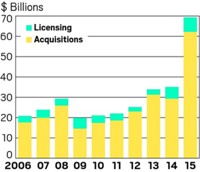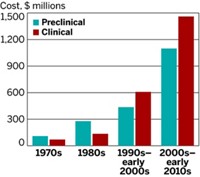Advertisement
Grab your lab coat. Let's get started
Welcome!
Welcome!
Create an account below to get 6 C&EN articles per month, receive newsletters and more - all free.
It seems this is your first time logging in online. Please enter the following information to continue.
As an ACS member you automatically get access to this site. All we need is few more details to create your reading experience.
Not you? Sign in with a different account.
Not you? Sign in with a different account.
ERROR 1
ERROR 1
ERROR 2
ERROR 2
ERROR 2
ERROR 2
ERROR 2
Password and Confirm password must match.
If you have an ACS member number, please enter it here so we can link this account to your membership. (optional)
ERROR 2
ACS values your privacy. By submitting your information, you are gaining access to C&EN and subscribing to our weekly newsletter. We use the information you provide to make your reading experience better, and we will never sell your data to third party members.
Business
Return On Pharma R&D Spending Hits New Low In 2015
Analysis: Increasing costs, declining drug sales puts 2015 R&D payback at six-year low
by Ann M. Thayer
January 29, 2016
| A version of this story appeared in
Volume 94, Issue 5

Every silver lining has its cloud. Although FDA’s approval of 45 new drugs in 2015 is an almost two-decade high, the returns that large pharmaceutical companies generated from their R&D investments hit a new low. In 2015, the average rate of return fell to 4.2% from 10.1% in 2010, according to the Deloitte Centre for Health Solutions.
Deloitte, a consulting firm, factored in development costs and forecasts of peak annual sales for the late-stage drug pipelines of 12 major pharma companies. The poor return in 2015 compared with 2010 came from a “stark imbalance” between costs, which have risen 33% to an average $1.58 billion per drug, and predicted peak sales, which have fallen 50% to $416 million.
Since 2010, the 12 drug firms have launched 186 products with estimated lifetime revenues of $1.26 trillion and moved 306 candidates into late-stage development.
Between external market pressures and internal productivity challenges, “life sciences R&D is not currently generating a significant return on investment,” says Deloitte Partner Julian Remnant.
On a positive note, the impact from terminated R&D projects dropped by more than 60% to about $30 billion for the group. And at individual companies, good returns can arise from consistent efforts in a therapy area and a focus on specialized drugs.
Deloitte also looked at four mid- to large-sized companies—AbbVie, Biogen, Celgene, and Gilead. With 25% lower costs and 130% higher forecast sales than the group of 12 large firms, the four had an R&D return of 17%. This success, Deloitte concluded, points to the “economic viability of a different R&D business model.”
For this smaller group, the revenue side of the equation is greatly skewed by high-priced products, such as Gilead’s hepatitis C drug Sovaldi, points out John LaMattina, a director at the venture firm PureTech and former Pfizer research head. Even excluding Sovaldi, Deloitte analysts say the small group’s forecast sales remain 57% higher.
Declining peak sales will continue to influence returns at companies of all sizes. With payers trying to negotiate down drug costs, LaMattina says, “there are going to be more downward pressures on drug revenues.”





Join the conversation
Contact the reporter
Submit a Letter to the Editor for publication
Engage with us on Twitter